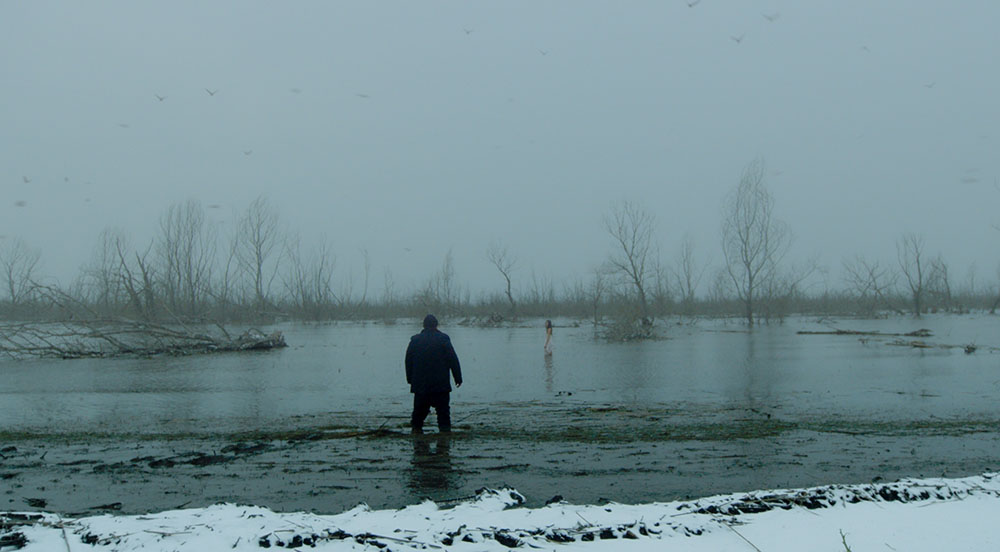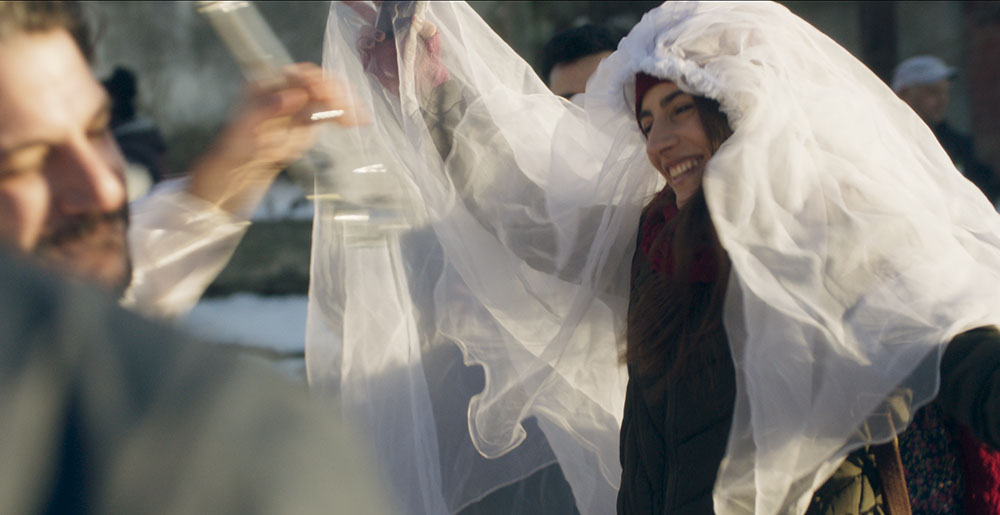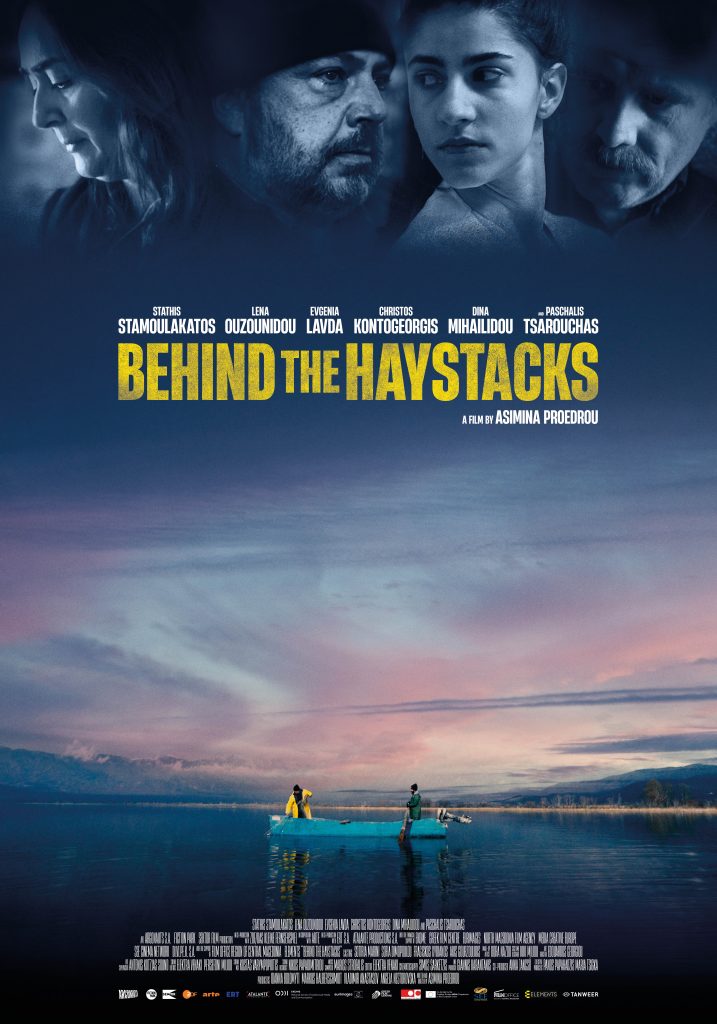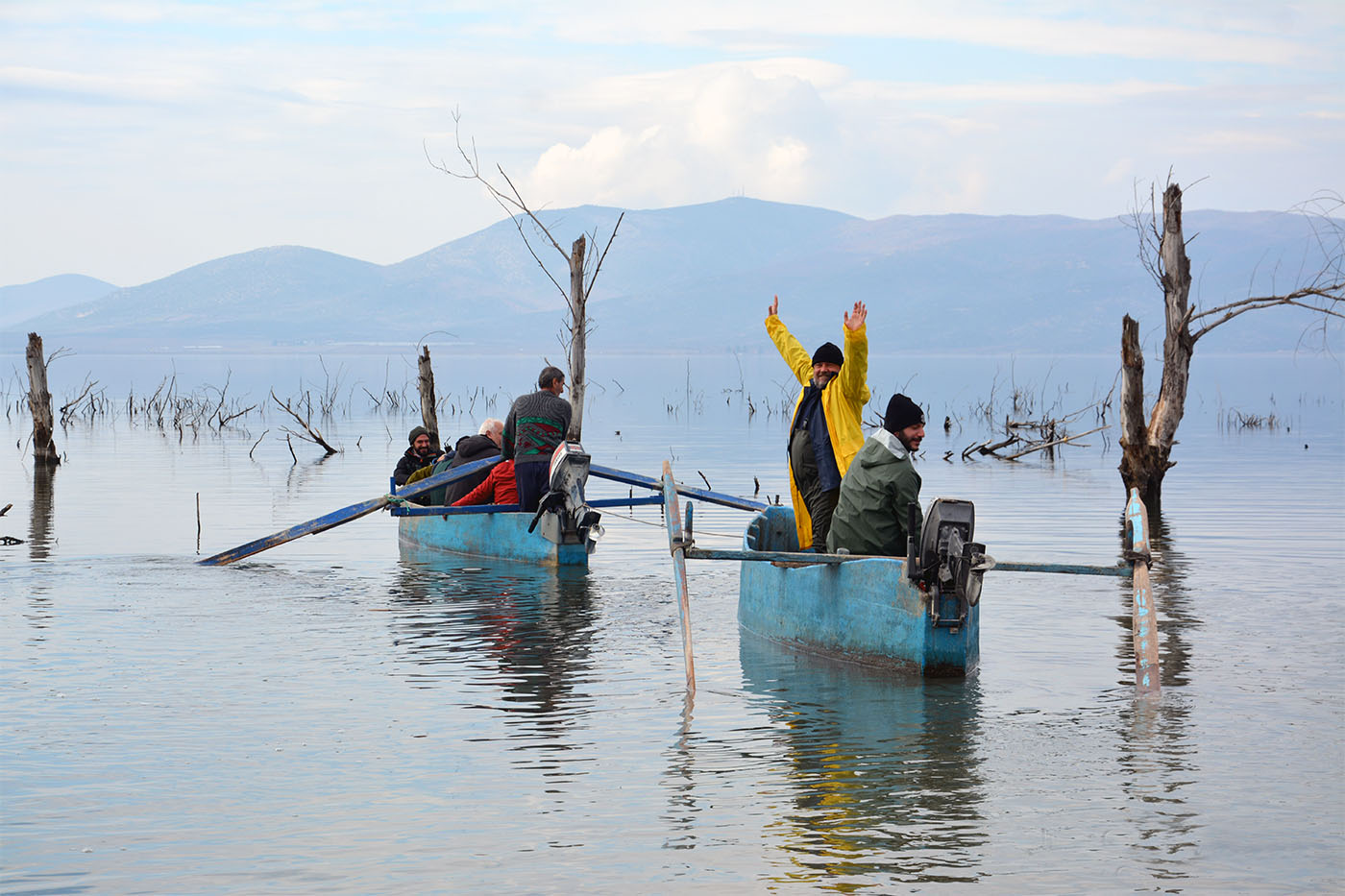Migrants passing through the Greek-Northern Macedonian border unstitch an introverted community’s suppressed strains in ascendant Greek cinema’s much-awarded latest offering. Behind the Haystacks, written and directed by Asimina Proedrou, has just landed an unprecedented 17 nominations to the Greek Cinema Academy Awards.
Iason Athanasiadis
Stergios lives a pretty typical life in a village around the dazzling Doïrani (or Dojran) Lake shared between Greece and Northern Macedonia. He argues with other farmers over financials in the local farmers’ cooperative, drives his large truck to the lakeshore to fish, and frequents the out-of-town strip joint. His wife fears him and his daughter alternates between affection, meticulous concealment of her private life, and eventually defiance. This sets the scene for a tragic denouement among the reed beds of the unearthly lake.
“I wanted to make a film about how society pressures everyday people and their social relations and forces them into crushing decisions and corruption,” first-time director Asimina Proedrou explained during a recent conversation, “but without absolving them of responsibility.”
Proedrou sets her bleak tale — about how the lines of refugees winding their way from a crushed Middle East to a prosperous northern Europe impact an isolated community — in a misty wetland of the Balkan periphery. A gendered narration frames the encounter between the Greek community and the cultural and geographic outsiders, with the three main characters contributing partial and non-consecutive perspectives on the parallel processes of greed, compassion and rivalry that escalate to the film’s climactic purge.
Few films in Greece have been made about the 2015 refugee crisis, but Behind the Haystacks seems to have struck a chord, winning prizes at the Thessaloniki and Goa film festivals, enjoying a four-month run at Greek cinemas, and winning 17 nominations at the Greek Cinema Academy Awards, an all-time high. Its immersive plunge into the collision of different worlds is now set for European cinema distribution, online streaming and television broadcast through cofunders Arte and ZDF.
Releasing the refugee genie
It is 2015, and Berlin has decided to mix the practical with the ethical: replenish its ageing labor force with fresh bodies and minds, while making a global broadcast of German virtue at a time when millions of refugees fleeing the aftermath of the Arab Spring and US occupations in Afghanistan and Iraq search for refuge. But as months pass and the refugee flows show no sign of abating, the original images of deliriously smiling citizens crowding into railway stations to greet crowds arriving from war-scarred regions are replaced with cultural clashes in German towns and the electoral rise of the Far Right. Politicians apprehensively realize that they may have let an irrepressible genie out of the bottle, and strike a deal with Turkey to close down the flows, angering those EU member states located between Turkey and the German border which must deal with the repercussions of the deal going wrong.
Stergios lives in a village on Doïrani Lake, a secluded habitat straddling the Greek-North Macedonia border that the closed borders transform into a sizzling hotspot. Driving back from a regular visit into North Macedonia, he hears on the car radio that Germany is shutting access to refugees. The decision sets a domino motion of closures from Austria through to the Balkans, snapping a new Fortress Europe into place. As North Macedonia shuts its own borders to migrants seeking to enter from Greece, fresh human waves pile up against the border, creating the once-notorious Idomeni camp but also a lucrative smuggling opportunity for Stergios.

Secrets of the swamp
Rather than a non-place, Doïrani is mired in the secret and suppressed histories illuminating the unpalatable side of how nation-states are stitched together. Its residents were batted back and forth by battles of possession between empires, nation-states and now liquid modernity. Today’s village residents are the descendants of the Greek-speaking Christian populations of the Pontic Black Sea, swapped between Greece and Turkey in 1923 and settled in formerly Slav-populated regions of northern Greece to Hellenize them. Conflict scattered their predecessors — whether Slavs and Bulgarians fleeing the Greek Army, or Greeks joining refugee lines to nearby Thessaloniki during the short-lived Kingdom of Serbia.
“I wanted to also register the other side’s music — the so-called Yugoslavika played with an accordion – in a small reference to [Serbian film director Emir] Kusturica, and also included in the celebration scene Makedonitika songs,” said Proedrou in our interview for The Markaz Review. “Initially I used the music just to signpost the region, but realizing the great commonalities between northern Macedonian, Yugoslav and Greek songs, I sought to highlight how all these cultural elements coexist on all sides of the borders.”
Signs of the disturbed past survive into today’s village: British and Greek First World War-era cemeteries, a disused railway station, and a Customs building demarcating the border. All form gateways: soldiers and settlers arrived on the train; the graveyards embraced those who perished in the conflict; while the Customs building selling expensive western liquors and cigarettes holds the promise of a future prosperity postponed for decades by a semantic struggle between Athens and Skopje over their mutual claim to the name Macedonia.

This is the historical minefield into which the refugees wander. Blocked off in their ramshackle camp and absorbed by the struggle to move forward, they will witness far less of the intimacies of the land than the film’s viewer, for whom director Proedrou conjures up a set of characters engaged in ancient traditions — from dancing through the village in animal hides during the ancient Momogeri ritual reintroduced in the 1920s by Pontic refugees, to an intoxicated, topless, all-male, feast-day sing-along. Throughout the film, the dictates of the overarching institutions that govern society — blood, borders and belief — invisibly drive the plot forward.
Cross-border dimensions
Stergios’ wife, the devout Maria, helps out at the local church. The women there are split on whether to help the mostly Muslim refugees. Maria, whom the priest has assigned fundraising for church repairs and to lay down his anti-Muslim line among the other women, is drawn to the parallel world of the cardboard and plastic waste refugee settlement that springs up locally, a wild place flourishing up against the border, for as long as hope remains that the gates will eventually reopen. While there, she scolds a woman she knows from the church for handing out food: helping the refugees is a sin, she says, echoing the priest.
 Meanwhile Stergios, who faces jail time due to tax trouble with the authorities, sees an income opportunity in the closing of the borders. Along with his brother-in-law, they start shipping boatloads of refugees to the lake’s northern Macedonian shore. At €1,000 a passenger, business is good. Stergios can afford to contribute handsomely to church repairs and buy his daughter the new smartphone she craves. But one night, the boat overturns and lives are lost. From that moment on, time ticks down on the protagonists.
Meanwhile Stergios, who faces jail time due to tax trouble with the authorities, sees an income opportunity in the closing of the borders. Along with his brother-in-law, they start shipping boatloads of refugees to the lake’s northern Macedonian shore. At €1,000 a passenger, business is good. Stergios can afford to contribute handsomely to church repairs and buy his daughter the new smartphone she craves. But one night, the boat overturns and lives are lost. From that moment on, time ticks down on the protagonists.
“It’s a film about how a corrupt society reproduces itself,” Proedrou explained, “and about how ordinary people are trapped inside a corrupt system that reproduces conservative behaviors.”
The EU’s monumental 2015 refugee opening has not figured in film much, perhaps due to its ambiguous and ongoing legacy. Behind the Haystacks succeeds in the harder task of harnessing the affair to an examination of what effect the newcomers had on the Balkan hinterlands’ historically disregarded communities. Along the way, it reveals how slight the cultural distance is between locals and refugees, despite mutual prejudices. Although the migration angle was sparked by chance conversations that Proedrou had with refugees staying in the Doïrani village hotel during a reccie [film industry jargon for “reconnaissance”], it evolved into the film’s narrative backbone.
The film’s shakily moving handheld camera and tight, shallow-focused frames move the action along atmospherically but they are also the result of a threadbare budget. Proedrou and her team achieved their shots by employing techniques like multiple camera angles and frequent changes of their sparse extras’ outfits. Matched with the brooding winter weather and humble village homes, the film elicits a claustrophobic atmosphere that conveys us along the jagged chunks of storyline we are called upon to arrange.
“I was always bewitched by cross-border stories because they have an added symbolism and dimension,” said Proedrou. “They depart from the local and acquire a more ecumenical character.”
Behind the Haystacks presents a Balkan tale in the time of resurgent geopolitics; and the unintended interplays exerted by two refugee communities — one just-uprooted, the other settled in the traces of a banished third — on each other.




